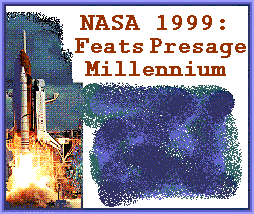 |
NASA 1999: Discoveries and Accomplishments Are a Taste of What's to Come in Next Century |
| Hubble's Expanding Universe. Planet Orbiting Pair of Stars. 3-D Map of Mars. Gamma Ray Bursts. Female Shuttle Commander. Space Shuttle Docks at International Space Station. Chandra X-Ray Observatory. X-34 Rocket Plane. Terra Earth Observing Satellite. | |
|---|---|
